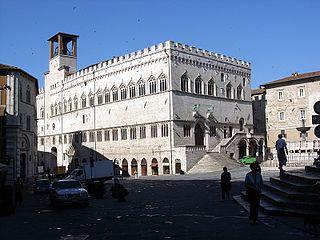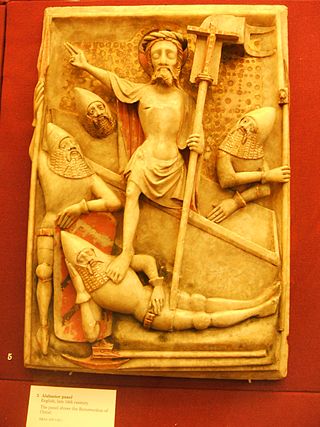
Perugia is the capital city of Umbria in central Italy, crossed by the River Tiber. The city is located about 164 km (102 mi) north of Rome and 148 km (92 mi) southeast of Florence. It covers a high hilltop and part of the valleys around the area.

Luca Signorelli was an Italian Renaissance painter from Cortona, in Tuscany, who was noted in particular for his ability as a draftsman and his use of foreshortening. His massive frescos of the Last Judgment (1499–1503) in Orvieto Cathedral are considered his masterpiece.

Benedetto Bonfigli was an Italian Renaissance painter born in Perugia, and part of the Umbria school of painters including Raphael and Perugino. He is also known as Buonfiglio. Influenced by the style of Domenico Veneziano, Benozzo Gozzoli, and Fra Angelico, Bonfigli primarily painted frescos for the church and was at one point employed in the Vatican. His best-preserved work is the Annunciation, but his masterpiece is the decoration of the chapel of the Palazzo dei Priori. Bonfigli specialized in gonfaloni, a Perugian style using banners painted on canvas or linen. Little is known of his personal life, but he was an esteemed painter in Perugia before Perugino, who is said to be his pupil.

Pietro Perugino, an Italian Renaissance painter of the Umbrian school, developed some of the qualities that found classic expression in the High Renaissance. Raphael became his most famous pupil.

The Deposition, also known as the Pala Baglioni, Borghese Entombment or The Entombment, is an oil painting by the Italian High Renaissance painter Raphael. Signed and dated "Raphael. Urbinas. MDVII", the painting is in the Galleria Borghese in Rome. It is the central panel of a larger altarpiece commissioned by Atalanta Baglioni of Perugia in honor of her slain son, Grifonetto Baglioni. Like many works, it shares elements of the common subjects of the Deposition of Christ, the Lamentation of Christ, and the Entombment of Christ. The painting is on wood panel and measures 184 x 176 cm.

The Baptism of Christ is an oil-on-panel painting finished around 1475 in the studio of the Italian Renaissance painter Andrea del Verrocchio and generally ascribed to him and his pupil Leonardo da Vinci. Some art historians discern the hands of other members of Verrocchio's workshop in the painting as well.

The Master of Saint Francis was an anonymous Italian painter, perhaps of Pisan origin though probably trained in Umbria, working between 1250–1280. His work embodies an important aspect of the Italo-Byzantine style resulting from contact between Italian and Byzantine art of this period.

The Mond Crucifixion or Gavari Altarpiece is an oil on poplar panel dated to 1502–1503, making it one of the earliest works by Italian Renaissance artist Raphael, perhaps the second after the c.1499-1500 Baronci Altarpiece. It originally comprised four elements, of which three survive, now all separated: a main panel of the Crucified Christ with the Virgin Mary, Saints and Angels which was bequeathed to the National Gallery, London, by Ludwig Mond, and a three-panel predella from which one panel is lost; the two surviving panels are Eusebius of Cremona raising Three Men from the Dead with Saint Jerome's Cloak in the Museu Nacional de Arte Antiga, in Lisbon, and Saint Jerome saving Silvanus and punishing the Heretic Sabinianus in the North Carolina Museum of Art.

The Palazzo dei Priori or comunale is one of the best examples in Italy of a public palace from the communal era. It is located in the central Piazza IV Novembre in Perugia, Umbria. It extends along Corso Vannucci up to Via Boncambi. It still houses part of the municipality, and, on the third floor, the Galleria Nazionale dell'Umbria. It takes its name from the Priori, the highest political authority governing the city in the medieval era.

Bartolomeo Caporali was an Italian painter and miniaturist in Perugia, Umbria during the early Renaissance period. His style was influenced by Umbrian artists Gozzoli and Boccati, two of his first mentors, and continued to evolve as younger Umbrian artists came onto the scene, such as Fiorenzo di Lorenzo, Perugino and Pinturicchio. Although primarily a painter, he is also known for executing missals, restoration work, gilding, armorials, banners and celebratory decorations, which speaks to his decorative, detail-oriented artistic style. His most famous works include Madonna and Saints (1487) for the church of Santa Maria Maddalena at Castiglione del Lago, The Virgin and Child Between Two Praying Angels, and his Adoration of the Shepherds.

Andrea di Aloigi, called L'Ingegno, was an Italian Renaissance painter.

The resurrection of Jesus has long been central to Christian faith and Christian art, whether as a single scene or as part of a cycle of the Life of Christ. In the teachings of the traditional Christian churches, the sacraments derive their saving power from the passion and resurrection of Christ, upon which the salvation of the world entirely depends. The redemptive value of the resurrection has been expressed through Christian art, as well as being expressed in theological writings.

The Adoration of the Magi is a painting by the Italian Renaissance painter Pietro Perugino, housed in the Galleria Nazionale dell'Umbria of Perugia, Italy.

The Madonna in Glory with Saints is a painting by the Italian Renaissance painter Pietro Perugino, dating to c. 1500–1501. It is housed in the Pinacoteca Nazionale of Bologna, Italy.

The San Pietro Polyptych is a polyptych by Italian Renaissance master Perugino, painted around 1496–1500. The panels are now in different locations: the lunette and the central panel, depicting the Ascension of Christ, are in the Museum of Fine Arts of Lyon, France.

Adoration of the Magi is a 1504 fresco by Perugino in the Oratorio di Santa Maria dei Bianchi in Città della Pieve. It shows the Adoration of the Magi, with an idealised view from Città della Pieve towards Lake Trasimene and Val di Chiana in the background. It is often compared to the Adoration of the Magi in the Sala delle Udienze del Collegio del Cambio in Perugia by Perugino and his studio, which includes areas argued by some art historians to have been painted by a young Raphael.

Madonna della Consolazione is an oil on panel painting by Perugino, datable ca. around 1496–1498. The work, completed in April 1498, was carried out in the Sala delle Udienze of the Collegio del Cambio. Since c. 1820 it is preserved in the National Gallery of Umbria in Perugia.

The Gonfalon of Justice is a tempera and oil on canvas painting by Perugino, dating to around 1501 and now housed in the Galleria Nazionale dell'Umbria in Perugia.

The Transfiguration Altarpiece is an altarpiece of the Transfiguration of Jesus by Perugino, dating to 1517 and now in the Galleria Nazionale dell'Umbria in Perugia.
The Collegio del Cambio frescos are a series of allegorical fresco paintings in the Audience Chamber of the Collegio del Cambio in Perugia, painted by Perugino.



















